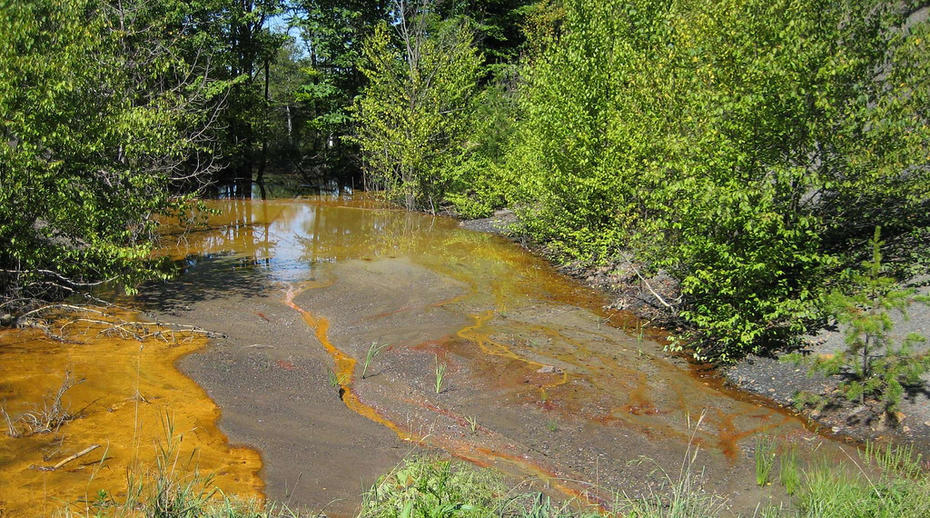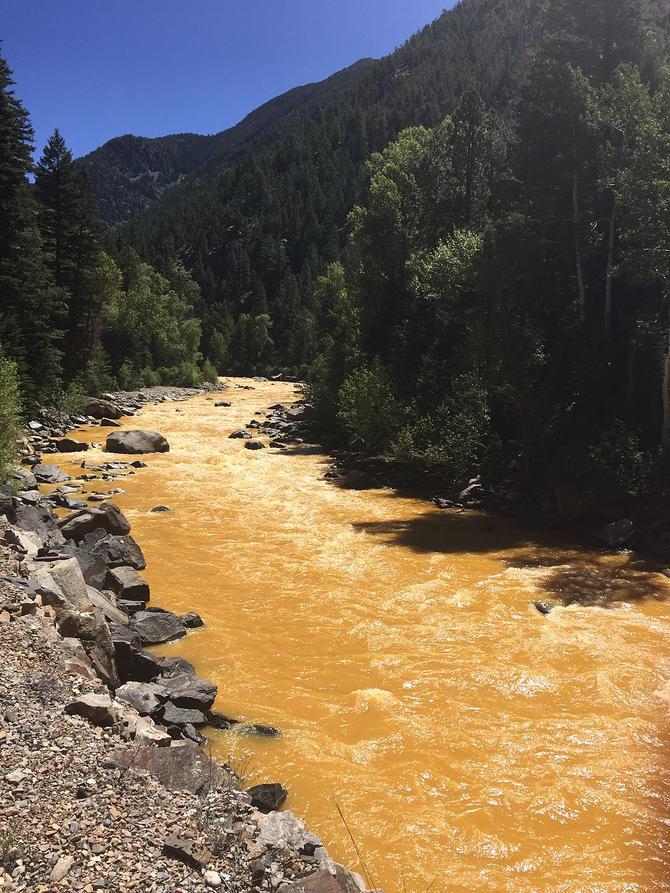An investigation by the United States Environmental Protection Agency at Colorado’s Gold King mine went badly awry earlier this month, triggering a spill of zinc, iron, copper, and other heavy metals into Cement Creek. From there, three million gallons of polluted water flowed into the Animas River and eventually Lake Powell. As the mustard-colored plume crept south, three states and the Navajo Nation declared states of emergency.
Since the August 5th incident, EPA critics have heaped blame on the agency. Florida senator Marco Rubio called the agency “arrogant.” Representative Scott Tipton of Colorado said, “If a mining operator or other private business caused the spill to occur, the EPA would be all over them.”
You can insert your own joke here about members of Congress accusing others of arrogance and unaccountability. A more serious point to make, though, is that Congress created this situation. The American West is speckled with thousands of abandoned mines dangerous to both environmental and human welfare, and the EPA has been left to clean up the mess without adequate resources. Politicians—the people tasked with providing those resources—are as much to blame for the disaster as the EPA.
A DIRTY HISTORY
If you wanted to open a mine around the turn of the 20th century, the federal government only had two demands: Provide adequate ventilation and don’t employ miners younger than 13. That was it. There were no inspections and certainly no environmental standards. State regulations were equally spare. Pollution simply wasn’t a major concern in the era when Gold King—and thousands more now-abandoned mines—operated.
“I’ve spoken to older miners who worked in the 1920s and ’30s,” says Ron Cohen, a professor of civil and environmental engineering at the Colorado School of Mines. “They didn’t think about disrupting the environment. They were supporting the economic development of the country through two world wars. This was their front.”

The environmental bill, however, would eventually come due. For example, many hard-rock mines, like Gold King, contain pyrite, or “fool’s gold.” When pyrite is exposed to air and water, it creates a solution that can leach heavy metals out of the surrounding rock. This toxic cocktail, known as acid mine drainage, flows out of many abandoned mines around the country.
THE SCALE OF THE PROBLEM
Trying to plug every leaky mine in the U.S. is a colossal task. A typical mine has several features that can contribute to water contamination, including entryways, dams, and holding bins for excavated rocks. Add those together and Colorado alone has 4,670 potential sources of pollution. The state’s abandoned mines release three million gallons of contaminated water into local waterways—the same volume as the Gold King spill—every two days. Many other states face the same problem. California has 5,200 pollution points in and around abandoned mines. Montana, Idaho, Pennsylvania, and Arizona are also burdened by abandoned mines.
In addition to ongoing leaks, accidents at these sites occasionally release huge amounts of effluent all at once. According to data compiled by Cohen, over the last two decades, spills many times the size of the Gold King accident have occurred in abandoned mines in Tennessee, Mississippi, Florida, Kentucky, and Arizona.
States don’t have the resources to properly seal up every abandoned mine, either. Colorado estimates that it spends $5,000 to deal with each problem area within a mine. Since the state has 10,818 locations that pose safety hazards, like open mine shafts, in addition to its 4,670 environmental threats, addressing these issues will eventually cost around $80 million—the state’s annual budget for it is $2 million.
WHAT HAPPENED AT GOLD KING MINE
Against this backdrop, states like Colorado call on the EPA for assistance for its deserted mines. The agency investigates the site and builds bulkheads—concrete plugs to stop the escape of acid mine drainage. This is difficult and uncertain work. “The workings in these abandoned mines are not documented, and you can’t go down there because it’s flooded and dangerous,” Cohen says. “It’s really a scientific guess as to how much water is there.”

Underfunding, understaffing, and a history of trying to do remediation on the cheap all played into the challenge Gold King presented to the agency. Colorado struck a deal in 1996 with the owner of the nearby Sunnyside mine, allowing the company to turn off its water-filtration system and merely plug up the exit points—essentially replacing a top-notch effluent-management system with a Band-Aid. As a result, contaminated water began building up in all the surrounding mines.
The EPA has been working to seal the mines in the area, but it didn’t have the manpower or time to finish the Gold King job before the ground froze in the fall. (The mine is about 11,000 feet above sea level.) So it decided to hastily construct an earthen dam with a system of drainage pipes to hold the pollution until a better barrier could be constructed. That was a bad decision. The dam failed.
MORE OF THE SAME
It’s unfortunate that the EPA has been made the only scapegoat in this accident. Inadequate regulations and insufficient funding put the agency in a position where one bad decision could cause a major accident. Under those conditions, an accident was nearly inevitable.
Here’s what’s even more troublesome: This is the status quo of mining in the U.S. Every mining disaster—whether at an abandoned or active mine, involving human or environmental tragedy—is followed by accusations and vows to do better. But the improvements are mind-bogglingly slow.
For example, a 1907 explosion in a coal mine in Monongah, West Virginia, killed at least 362 people, with only one single miner escaping from the mine. The following year, state mine inspectors formed a national committee to share ideas and prevent similar disasters. It didn’t work. The very next year, 1909, set a record for coal-mine accidents, including the Cherry mine fire that killed 259 people. The next year saw the most mine disasters overall (including both coal and non-coal mines). The number of disasters in non-coal mines peaked in 1911. In 1922, University of Colorado chemist John B. Ekeley called the mine-inspection system “entirely inadequate,” suggesting the reforms had done little or nothing. Take a brief stroll through Google Books and you’ll see dozens of writers in every decade criticizing mine inspections. It probably shouldn’t surprise us that mining is a Groundhog’s Day industry.
I’m not suggesting the EPA is blameless in the Gold King spill, but we’ve created a situation where one bad call can contaminate 300 miles of river with toxic metals. That’s a systemic failure, not an individual failure. If members of Congress want to point fingers at all the people at fault for the accident, they’ll need to grow a digit for every seat on Capitol Hill.
This post originally appeared on Earthwire as “Hey, Congress, Quit Blaming the EPA” and is re-published here under a Creative Commons license.




